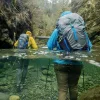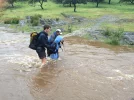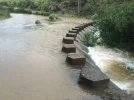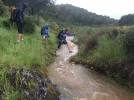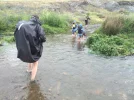- Time of past OR future Camino
- 2012, 2013, 2014.
-
Remove ads on the forum by becoming a donating member. More here.
Search 74,075 Camino Questions
You are using an out of date browser. It may not display this or other websites correctly.
You should upgrade or use an alternative browser.
You should upgrade or use an alternative browser.
Wet conditions on the Camino.
- Thread starter wayfarer
- Start date
Perfect memento/gift in a presentation box. Engraving available, 25 character max.
SYates
Camino Fossil AD 1999, now living in Santiago de C
- Time of past OR future Camino
- First: Camino Francés 1999
...
Last: Santiago - Muxia 2019
Now: http://egeria.house/
Yup, crossing streams on the Via de la Plata can be hazardous  Buen Camino, SY
Buen Camino, SY
W
whariwharangi
Guest
I would at least roll up my trousers ...
Get a spanish phone number with Airalo. eSim, so no physical SIM card. Easy to use app to add more funds if needed.
- Time of past OR future Camino
- 2013,2014,2015,2016x2,2017,2021,2022,2023,2024
The water is SO clear!! At least one can see where one is stepping!! 
Ok, with my fear of water, that would end my camino I am afraid. Wow, unbelievableConditions are a bit wet on the Camino at the moment....
View attachment 28317
Photo courtesy of Amazing World Places.
Kiwi-family
{Rachael, the Mama of the family}
- Time of past OR future Camino
- walking every day for the rest of my life
Ideal sleeping bag liner whether we want to add a thermal plus to our bag, or if we want to use it alone to sleep in shelters or hostels. Thanks to its mummy shape, it adapts perfectly to our body.
€46,-
€46,-
That is very scary, will have to research that part of the journeyView attachment 28319 Hasn't changed too much since June then;-)View attachment 28321 View attachment 28322
OK, am breathing again, did my research, not part of Camino Frances!That is very scary, will have to research that part of the journey
- Time of past OR future Camino
- All that we are is the result of what we have thought.
Love the picture.Conditions are a bit wet on the Camino at the moment....
View attachment 28317
Photo courtesy of Amazing World Places.
Looks like it's not raining anymore, that's good. !!!
Wish you well, Peter.
Perfect memento/gift in a presentation box. Engraving available, 25 character max.
gerardcarey
Veteran Member
- Time of past OR future Camino
- CFx2, CPx1
Some people just don't use their noggins.
Don't you think they'd use a pack cover.
I would've worn me poncho at least.
Don't you think they'd use a pack cover.
I would've worn me poncho at least.
Kitsambler
Jakobsweg Junkie
- Time of past OR future Camino
- SJPP 2023
If you rigged the poncho properly over the hiking poles, you'd have a boat.I would've worn me poncho at least.
gerardcarey
Veteran Member
- Time of past OR future Camino
- CFx2, CPx1
What a good idea that is! I can see myself now, as Toad, in "Wind in the Willows", going down the stream with Badger, Ratty and Mole running along the bank in pursuit.If you rigged the poncho properly over the hiking poles, you'd have a boat.
Thank you very much Kitsambler!
Gerard
€2,-/day will present your project to thousands of visitors each day. All interested in the Camino de Santiago.
D
Deleted member 43985
Guest
Maybe this will finally lead to agreement about the wisdom of waterproof footwear... 


Juanajoanna
Member
- Time of past OR future Camino
- Planning to bike spring 2017
Surely that is photoshopped!
Jeff Crawley
Veteran Member
- Time of past OR future Camino
- A "Tourigrino" trip once Covid has passed, so 2023
What a good idea that is! I can see myself now, as Toad, in "Wind in the Willows", going down the stream with Badger, Ratty and Mole running along the bank in pursuit.
Thank you very much Kitsambler!
Gerard
Go for it!
http://www.shelter-systems.com/kayak.html
http://www.shelter-systems.com/kayak.html
Or better still
http://koti.kapsi.fi/hvartial/coracle/coracle.htm
Which you could turn upside down and sleep under at night - instant refugio!
May we come along and watch?
The 2024 Camino guides will be coming out little by little. Here is a collection of the ones that are out so far.
- Time of past OR future Camino
- 2012, 2013, 2014.
Great links, thanks Jeff.
Jeff Crawley
Veteran Member
- Time of past OR future Camino
- A "Tourigrino" trip once Covid has passed, so 2023
camster
Active Member
- Time of past OR future Camino
- Camino Francés 2023
Are you kiddingView attachment 28319 Hasn't changed too much since June then;-)View attachment 28321 View attachment 28322
A selection of Camino Jewellery
Tia Valeria
Veteran Member
- Time of past OR future Camino
- Pt Norte/Pmtvo 2010
C. Inglés 2011
C. Primitivo '12
Norte-C. de la Reina '13
C. do Mar-C. Inglés '15
Would the Irish pilgrims, who recently sailed, be willing to lend their boat? see or maybe they could start a new life as ferrymen. I cannot find the link 
movinmaggie
Veteran Member
- Time of past OR future Camino
- 2015
Ideal test for waterproof socks!
Maybe this will finally lead to agreement about the wisdom of waterproof footwear...
No, it doesn't - when you see proper adventurers crossing rivers, they will typically take off their shoes and socks and put them on their shoulders to keep them dry
PS and why they need to use their poles I have no idea
A selection of Camino Jewellery
- Time of past OR future Camino
- Most years since 2012
? Maybe you are joking?why they need to use their poles I have no idea
However, maybe I'd find that the poles were not functional in that way in such deep water, and it is just a placebo. Can anyone comment?
Kiwi-family
{Rachael, the Mama of the family}
- Time of past OR future Camino
- walking every day for the rest of my life
This is the first time I've disagreed with GerardCarey (sorry).Some people just don't use their noggins.
Don't you think they'd use a pack cover.
I would've worn me poncho at least.
On our last Camino my kids did not use pack covers, but instead used Macpac waterproof liners - despite a serious amount of rain, and sometimes torrential, and despite their packs being absolutely sodden, not one drop got into their gear. (I still prefer my Packa raincoat, but this was a good alternative we tried after finding pack covers to be less than perfect. Of course, a pack cover as well would have been a good option this spring but we were cutting weight)
- Time of past OR future Camino
- Frances; Aragones; VdlP; Madrid-Invierno; Levante
@C clearly? Maybe you are joking?I have never been in that situation. However, my first thought is that I wouldn't attempt it without poles for balance, especially in moving water and when wearing a backpack which would make me top heavy. If the water isn't clear, I'd also want the poles to test for footing.
However, maybe I'd find that the poles were not functional in that way in such deep water, and it is just a placebo. Can anyone comment?
I have used a walking stick for river crossings since Wally, a backcountry warden in Jasper National Park, instructed me in their use many years ago. Face the flow of the river and place your walking stick upstream of you in the water. Lean on it with both hands as necessary, using it for balance. Walk sideways across the current to the opposite bank, placing the stick in the current upstream of you, a little ahead of your route. A stick helps to keep one's balance in the current and when negotiating an irregular bottom with rolling rocks. I have learned two important things since: 1. a stick which you pick up on the bank may break halfway across, dumping you in the river; 2. an expensive purchased walking stick, if collapsible, will take in water and collapse while you are partway across. I would expect that the same is true of some poles. I do not use walking poles, which is partly illogical, as I have not come across difficult river crossings on the camino. But I am used to using a stick for balance wherever I walk. The poles in the photo do not appear to me to have any function, as the water looks more like a lake than a river and has a fairly level bottom. I would not use walking poles for this purpose: comparatively fragile and most are collapsible.
Get a spanish phone number with Airalo. eSim, so no physical SIM card. Easy to use app to add more funds if needed.
- Time of past OR future Camino
- Most years since 2012
Some interesting points to consider - in particular, facing upstream while stepping sideways, and using a solid stick instead of hollow poles. Thanks!@C clearly
I have used a walking stick for river crossings since Wally, a backcountry warden in Jasper National Park, instructed me in their use many years ago. Face the flow of the river and place your walking stick upstream of you in the water. Lean on it with both hands as necessary, using it for balance. Walk sideways across the current to the opposite bank, placing the stick in the current upstream of you, a little ahead of your route. A stick helps to keep one's balance in the current and when negotiating an irregular bottom with rolling rocks. I have learned two important things since: 1. a stick which you pick up on the bank may break halfway across, dumping you in the river; 2. an expensive purchased walking stick, if collapsible, will take in water and collapse while you are partway across. I would expect that the same is true of some poles. I do not use walking poles, which is partly illogical, as I have not come across difficult river crossings on the camino. But I am used to using a stick for balance wherever I walk. The poles in the photo do not appear to me to have any function, as the water looks more like a lake than a river and has a fairly level bottom. I would not use walking poles for this purpose: comparatively fragile and most are collapsible.
Kiwi-family
{Rachael, the Mama of the family}
- Time of past OR future Camino
- walking every day for the rest of my life
If you look really closely in my first picture above, you'll see the guy who is helping us cross is using his pole in exactly the way mentioned. He also instructed the kids to face upstream and walk sideways. Unfortunately you do not have to look too closely to see son did not follow the admonition to keep his arms locked across his front at all times - the water was cold (you can see *that* on his face) and he let go a little subconsciously hoping to avoid the deeper patch! Of course it was not life-threatening, although I doubt the girls would have managed to cross on their own - the current was swift and the rocky bottom quite uneven.@C clearly
I have used a walking stick for river crossings since Wally, a backcountry warden in Jasper National Park, instructed me in their use many years ago. Face the flow of the river and place your walking stick upstream of you in the water. Lean on it with both hands as necessary, using it for balance. Walk sideways across the current to the opposite bank, placing the stick in the current upstream of you, a little ahead of your route. A stick helps to keep one's balance in the current and when negotiating an irregular bottom with rolling rocks. I have learned two important things since: 1. a stick which you pick up on the bank may break halfway across, dumping you in the river; 2. an expensive purchased walking stick, if collapsible, will take in water and collapse while you are partway across. I would expect that the same is true of some poles. I do not use walking poles, which is partly illogical, as I have not come across difficult river crossings on the camino. But I am used to using a stick for balance wherever I walk. The poles in the photo do not appear to me to have any function, as the water looks more like a lake than a river and has a fairly level bottom. I would not use walking poles for this purpose: comparatively fragile and most are collapsible.
If I had had my way, the kids would also have undone the hipbelts on their packs so that they could flip out of them if necessary, but this lovely guy who had stopped in the rain knowing that we would soon be coming and could use a hand across the stream which was rising quite fast, assured me there was no need - he would not let go of the youngest! When I crossed with the other two, we undid out packs because I was not so confident of my own ability. By the way, the pole was priceless in finding the bottom and steadying against the flow.
- Time of past OR future Camino
- Frances; Aragones; VdlP; Madrid-Invierno; Levante
If you look really closely in my first picture above, you'll see the guy who is helping us cross is using his pole in exactly the way mentioned. He also instructed the kids to face upstream and walk sideways. Unfortunately you do not have to look too closely to see son did not follow the admonition to keep his arms locked across his front at all times - the water was cold (you can see *that* on his face) and he let go a little subconsciously hoping to avoid the deeper patch! Of course it was not life-threatening, although I doubt the girls would have managed to cross on their own - the current was swift and the rocky bottom quite uneven.
If I had had my way, the kids would also have undone the hipbelts on their packs so that they could flip out of them if necessary, but this lovely guy who had stopped in the rain knowing that we would soon be coming and could use a hand across the stream which was rising quite fast, assured me there was no need - he would not let go of the youngest! When I crossed with the other two, we undid out packs because I was not so confident of my own ability. By the way, the pole was priceless in finding the bottom and steadying against the flow.
@Kiwi-family
It is very common in the Canadian Rocky Mountain parks to instruct hikers to undo their waist belts when crossing rivers and major streams. I tried it once. It put me extremely off balance. I prefer to retain my balance and avoid flipping over into the river. Of course, this is with a pack that is at least twice the weight of what I carry on camino. I really need to be stable when doing river crossings. Your crew appears to be managing very well, with a little help from a friend.
Train for your next Camino on California's Santa Catalina Island March 16-19
- Time of past OR future Camino
- Camino Frances 2007,
Via Francigena Italy, 2008,
Jakobsweg Austria 2010,
Camino Frances 2011,
Le Puy to Lourdes 2012,
Via de la Plata 2013,
Future:
Ökumenischer (Via Regia), Germany,
Lycian Way, Turkey
Reminds of me when I walked the via de la plata - had to cross a number of creeks including one that waist deep. This was followed a few days by a freak snow storm.
- Time of past OR future Camino
- Most years since 2012
@Kiwi-family and @Albertagirl - I did a bit of the VdlP in March, seemingly before the high waters and before I had to change plans for other reasons. Now I am very keen to get out there and test this new knowledge!
This illustrates how each of us needs to have some knowledge and then assess the risks as they apply in each case! I would be inclined to undo the belt, but I walk with only a 7 kg pack. I can see the point about the heavier pack!It is very common in the Canadian Rocky Mountain parks to instruct hikers to undo their waist belts when crossing rivers and major streams. I tried it once. It put me extremely off balance. I prefer to retain my balance and avoid flipping over into the river.
- Time of past OR future Camino
- Camino Frances 2007,
Via Francigena Italy, 2008,
Jakobsweg Austria 2010,
Camino Frances 2011,
Le Puy to Lourdes 2012,
Via de la Plata 2013,
Future:
Ökumenischer (Via Regia), Germany,
Lycian Way, Turkey
The picture also reminds of when my wife and I hiked the Abel Tasman coastal track in New Zealand and we crossed Torrent Bay estuary during high tide.
I was able to locate a sand bar that crisscrossed the entire estuary. I stripped down to my swimsuit, and waded across carrying my backpack above my head. I returned, and I repeated the same process carrying my wife's pack above my head. During the crossing, the water got so deep that I was barely able to carry the pack above my shoulders, without it touching the water.
I was able to locate a sand bar that crisscrossed the entire estuary. I stripped down to my swimsuit, and waded across carrying my backpack above my head. I returned, and I repeated the same process carrying my wife's pack above my head. During the crossing, the water got so deep that I was barely able to carry the pack above my shoulders, without it touching the water.
The one from Galicia (the round) and the one from Castilla & Leon. Individually numbered and made by the same people that make the ones you see on your walk.
- Time of past OR future Camino
- Frances; Aragones; VdlP; Madrid-Invierno; Levante
@jiritThe picture also reminds of when my wife and I hiked the Abel Tasman coastal track in New Zealand and we crossed Torrent Bay estuary during high tide.
I was able to locate a sand bar that crisscrossed the entire estuary. I stripped down to my swimsuit, and waded across carrying my backpack above my head. I returned, and I repeated the same process carrying my wife's pack above my head. During the crossing, the water got so deep that I was barely able to carry the pack above my shoulders, without it touching the water.
I was thinking that the photo reminded me of New Zealand. I walked part of the Abel Tasman track a couple of years ago, but did not overnight on it or attempt any water crossings.
- Time of past OR future Camino
- Camino Frances 2007,
Via Francigena Italy, 2008,
Jakobsweg Austria 2010,
Camino Frances 2011,
Le Puy to Lourdes 2012,
Via de la Plata 2013,
Future:
Ökumenischer (Via Regia), Germany,
Lycian Way, Turkey
@jirit
I was thinking that the photo reminded me of New Zealand. I walked part of the Abel Tasman track a couple of years ago, but did not overnight on it or attempt any water crossings.
Actually the photo reminds of a gorge on the island of Crete that my wife and I hiked.
During the wet season the water can run high.
- Time of past OR future Camino
- Camino Frances 2007,
Via Francigena Italy, 2008,
Jakobsweg Austria 2010,
Camino Frances 2011,
Le Puy to Lourdes 2012,
Via de la Plata 2013,
Future:
Ökumenischer (Via Regia), Germany,
Lycian Way, Turkey
However the photo was taken in Malaysia, not on the Camino in Spain
http://imgur.com/a7FrmoO
http://mykelah.com/sungai-chiling-fish-sanctuary-kuala-kubu-bharu-selangor/
http://imgur.com/a7FrmoO
http://mykelah.com/sungai-chiling-fish-sanctuary-kuala-kubu-bharu-selangor/
The focus is on reducing the risk of failure through being well prepared. 2nd ed.
Jeff Crawley
Veteran Member
- Time of past OR future Camino
- A "Tourigrino" trip once Covid has passed, so 2023
No, you take off your trousers and socks to keep them dry (ever tried walking in soused kecks?) but put your boots back on cos you don't want to step on a sharp stone and lose the lot.No, it doesn't - when you see proper adventurers crossing rivers, they will typically take off their shoes and socks and put them on their shoulders to keep them dry
PS and why they need to use their poles I have no idea
- Time of past OR future Camino
- Camino Frances 2007,
Via Francigena Italy, 2008,
Jakobsweg Austria 2010,
Camino Frances 2011,
Le Puy to Lourdes 2012,
Via de la Plata 2013,
Future:
Ökumenischer (Via Regia), Germany,
Lycian Way, Turkey
It's closer to home. The photo was taken at Washington Olympic Peninsula by photographer Ian Coble, see Mountain Hardwear . The backpacks are Mountain Hardwear Outdry backpacks which have a watertight main compartment.
See also http://blog.iancoble.com/behind-the-scenes-mountain-hardwear-commercial-shoot/
Humans: 1 - AI: 0
- Time of past OR future Camino
- 2012, 2013, 2014.
Excellent work. This photo popped up on a Facebook hill walking page here at home and I thought it was an excellent one. It also reminded me of all the discussions on waterproof boots, shoes and other gear.It's closer to home. The photo was taken at Washington Olympic Peninsula by photographer Ian Coble, see Mountain Hardwear . The backpacks are Mountain Hardwear Outdry backpacks which have a watertight main compartment.
See also http://blog.iancoble.com/behind-the-scenes-mountain-hardwear-commercial-shoot/
Perfect memento/gift in a presentation box. Engraving available, 25 character max.
- Time of past OR future Camino
- Frances; Aragones; VdlP; Madrid-Invierno; Levante
@Jeff CrawleyNo, you take off your trousers and socks to keep them dry (ever tried walking in soused kecks?) but put your boots back on cos you don't want to step on a sharp stone and lose the lot.
You are partly right: trousers, sock, boots off. Running shoes on. They can be tied to the pack and are often dry when you arrive in camp. I only wear boots for river crossings when I feel that I must for stability. Wet boots can take two or three days to dry even in dry weather.
Nanc
Active Member
- Time of past OR future Camino
- Frances (Sept 2016)
SDC/ Finesterre/ Muxia (2016)
crossing a stream with a pack fully belted has resulted in bad outcomes when someone slips and gets pinned (even on top of the pack belly up) or more seriously, if swept downstream snagging said pack on branches and debris
As for removing trousers to cross, I think I'll save the world from these pale legs and keep mine on!
As for removing trousers to cross, I think I'll save the world from these pale legs and keep mine on!
clearskiescamino
Veteran Member
- Time of past OR future Camino
- Too many to mention...
eh? no gaiters? 
Ideal sleeping bag liner whether we want to add a thermal plus to our bag, or if we want to use it alone to sleep in shelters or hostels. Thanks to its mummy shape, it adapts perfectly to our body.
€46,-
€46,-
gerardcarey
Veteran Member
- Time of past OR future Camino
- CFx2, CPx1
No no! You are quiet correct. I was being facetious as to those underwater people in wayfarers photograph.This is the first time I've disagreed with GerardCarey (sorry).
On our last Camino my kids did not use pack covers, but instead used Macpac waterproof liners - despite a serious amount of rain, and sometimes torrential, and despite their packs being absolutely sodden, not one drop got into their gear. (I still prefer my Packa raincoat, but this was a good alternative we tried after finding pack covers to be less than perfect. Of course, a pack cover as well would have been a good option this spring but we were cutting weight)
Mind you I do quite enjoy the ridiculous appearance I must present in my Altus. Except for one day when I had to walk thru Paris in the rain. I kept my head down hoping not to attract the attention of the fashion police.
Regards
Gerard
- Time of past OR future Camino
- 2012, 2013, 2014.
I saw it on the page "Amazing World Places" that is why I mentioned them in the OP.It has certainly sparked a lively discussion.
I was initially convinced that it was photoshopped, that's why I was determined to find the original. And when I had found it, I felt the photographer deserved some credit.
N
No problem. I'll just add an inflatable boat to my backpack. And an outboard motor. A 5 horsepower should do.Conditions are a bit wet on the Camino at the moment....
View attachment 28317
Photo courtesy of Amazing World Places.
Holoholo automatically captures your footpaths, places, photos, and journals.
Trevor Ockenden
Member
- Time of past OR future Camino
- SJPdP to Estella, Le Puy to Cahore, Porto to SdC
Some pilgrims will go to any lengths to take the weight off their feet.
Nika
New Member
- Time of past OR future Camino
- March (2017)
Very glad to hear that !OK, am breathing again, did my research, not part of Camino Frances!
Cedar Schimke
New Member
- Time of past OR future Camino
- Starting Camino Frances Late August (2016) from SJPDP
I almost wish it was! Adds to the adventureOK, am breathing again, did my research, not part of Camino Frances!
Perfect memento/gift in a presentation box. Engraving available, 25 character max.
SYates
Camino Fossil AD 1999, now living in Santiago de C
- Time of past OR future Camino
- First: Camino Francés 1999
...
Last: Santiago - Muxia 2019
Now: http://egeria.house/
I almost wish it was! Adds to the adventure
For that kind of adventure try the Via de la Plata during a rainy spring ;-) Buen Camino, SY
I do think I will have quite enough adventure without the water crossing!!!!I almost wish it was! Adds to the adventure
Kiwi-family
{Rachael, the Mama of the family}
- Time of past OR future Camino
- walking every day for the rest of my life
We have returned home to a very rainy winter and six weeks later the kids are still saying "At least we're not walking in it".
We look back with fondness on our Via de la Plata, but it was surely very wet. (And also got into the 30s, so there was quite a range)
We look back with fondness on our Via de la Plata, but it was surely very wet. (And also got into the 30s, so there was quite a range)
Perfect memento/gift in a presentation box. Engraving available, 25 character max.
We
Welcome home and I admire your stamina and perseverance .!!!We have returned home to a very rainy winter and six weeks later the kids are still saying "At least we're not walking in it".
We look back with fondness on our Via de la Plata, but it was surely very wet. (And also got into the 30s, so there was quite a range)
❓How to ask a question
How to post a new question on the Camino Forum.
Most read last week in this forum
I saw a video with a rather harsh criticism of a small, municipal albergue on one of the less traveled caminos. They paid 9€. I thought: What does it cost a small municipality to renovate and keep...
On my last Camino (2023) I noticed that there were lots of tourists. It reminded me of a couple of quotes that I have read since my first Camino (2015)
“A tourist demands, a pilgrim is grateful”...
"A complete guide to the world's greatest pilgrimage"[sic] by Sarah Baxter.
In a British newspaper, The Telegraph. A right wing daily that does print interesting articles and essays...
I've been trying to figure out how to use the Gronze app and as a first step I need to translate into English - I searched topics on the Forum, thought I found what I was looking for, and Yay! I...
There was a recent thread about EST (Erhard Seminars Training) which I have to say I have never hear of, but it got me thinking.
I undertook some rather 'left field' training about 10 years ago...
Similar threads
- Replies
- 65
- Views
- 4K
- Replies
- 8
- Views
- 1K
- Replies
- 46
- Views
- 2K
- Replies
- 50
- Views
- 3K
LIVE from the Camino
Cameron's Verde - October 2024 condition report
- Replies
- 4
- Views
- 399
❓How to ask a question
How to post a new question on the Camino Forum.
Latest posts
-
-
-
Where do ( did ) you walk locally in 2024?
- Latest: Rick of Rick and Peg
-
Re-designing My Sleep System for Weight and Comfort
- Latest: Rick of Rick and Peg
Most downloaded Resources
-
“All” Albergues on the Camino Frances in one pdf“All” Albergues on the Camino Frances in one pdf
- ivar
- Updated:
-
A selection of favorite albergues on the Camino FrancésFavorite Albergues along the Camino Frances
- Ton van Tilburg
- Updated:
-
Profile maps of all 34 stages of the Camino FrancesProfile maps of all 34 stages of the Camino Frances
- ivar
- Updated:


